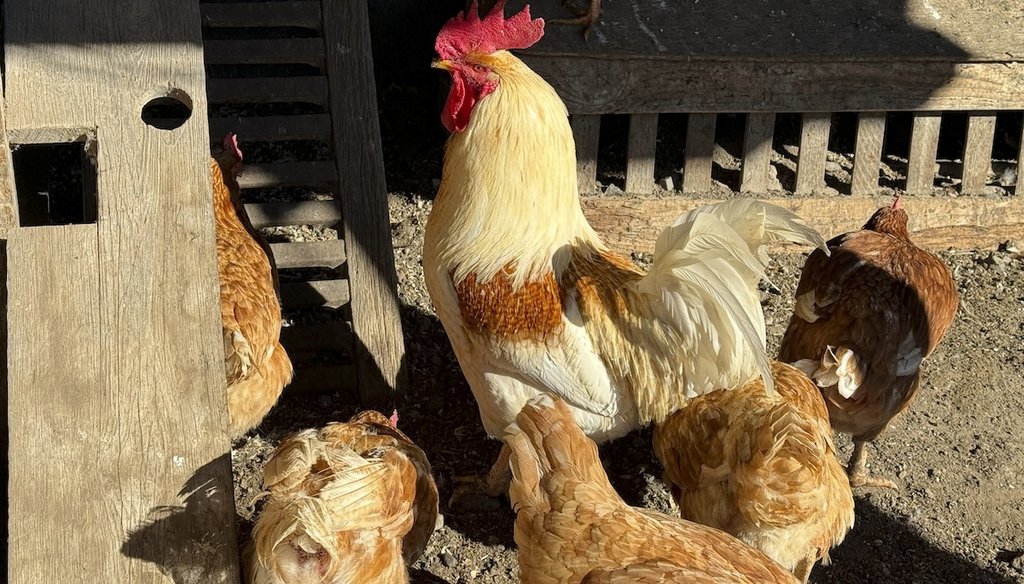Stand up for the facts!
Our only agenda is to publish the truth so you can be an informed participant in democracy.
We need your help.
I would like to contribute

Chickens stand in a holding pen at Ettamarie Peterson's farmin Petaluma, Calif. on Thursday, Jan. 11, 2024. Since 2022, H5N1 avian influenza has affected more than 82 million birds across the country, U.S. officials said. (AP)
If Your Time is short
-
Public health authorities say avian influenza poses low risk to the general public. One person in the U.S. was recently diagnosed with bird flu. There are no signs the disease is spreading human-to-human.
-
Bird flu infections in humans are rare. There have been sporadic cases and outbreaks among humans globally for nearly three decades.
-
Officials say it’s safe to eat properly cooked poultry and eggs. Pasteurized dairy products are also safe to eat.
-
Our mission: Help you be an informed participant in democracy. Learn more.
Recent U.S. outbreaks of avian influenza and the first known case of a human contracting bird flu from a mammal have ignited concerns that bird flu will be the next pandemic.
Some social media users are claiming bird flu will be worse than COVID-19, which caused more than 1.2 million U.S. deaths since 2020.
"GET READY because the fabled ‘Disease X’ COVID PLANDEMIC 2.0 IS on the horizon, and it looks like it’s the ‘Avian Influenza’ Bird Flu H5N1 variant," an April 4 X post said.
Another X post, featuring butchered grammar, said, "Here we go …. Again. Scientists says Bird Flu pandemic could be ‘100 times worse’ than COVID."
Other X users said public health authorities are "already working" on a bird flu vaccine for humans, suggesting the disease outbreak was planned.
Public health experts in the U.S. and worldwide say avian flu poses a low risk to humans, and there have been no signs of human-to-human spread of the disease. Developing a bird flu vaccine is part of the federal government’s pandemic preparedness.
What is bird flu?
Avian influenza is a naturally occurring disease among wild birds, including ducks and geese, that can also infect domesticated birds, such as chickens and turkeys. Highly pathogenic strains of bird flu can cause severe infection and high fatality in birds. Low pathogenic strains trigger mild infections, but can turn highly pathogenic.
Domesticated birds can contract avian flu through contact with infected birds, or through contact with surfaces contaminated with the virus. Because avian flu spreads quickly and is untreatable in animals, infected flocks are culled to prevent further infection.
How widespread is the bird flu outbreak in the U.S.?
This strain of highly pathogenic avian influenza, H5N1, was discovered in wild birds in the U.S. and Canada in late 2021, the Centers for Disease Control and Prevention said. In 2022, the virus began causing outbreaks in commercial and backyard poultry.
Since 2022, H5N1 bird flu has affected more than 82 million birds across almost every state, the CDC said. That means they live on premises where the flu has been detected. Sporadic infections of other wild animals, including bears, foxes and skunks, have also been reported.
Recently, the virus spread to livestock for the first time. In March, U.S. officials reported that goats on a Minnesota farm tested positive for H5N1. Since then, the avian flu has also been detected in dairy cows in Idaho, Kansas, Michigan, New Mexico, Ohio and Texas.
At the beginning of April, the country’s largest egg producer, Cal-Maine Foods Inc., said it was temporarily halting production at a Texas plant after bird flu was found in its chickens. A Michigan poultry plant also reported bird flu infections.
As of April 10, the U.S. Agriculture Department’s Animal and Plant Health Inspection Service said avian flu affected more than 3.85 million birds in commercial and backyard flocks in Michigan, South Dakota and Texas over the past 30 days.
How often do people get infected with bird flu?
It’s unusual for people to contract avian flu, but rare cases have occurred globally for nearly three decades, the CDC said. Infections can happen when the bird flu virus gets into a person’s eyes, nose or mouth, or is inhaled.
The first bird flu outbreak among humans happened in 1997 in Hong Kong, and about 20 people were infected, the CDC said.
No human cases were reported between 1998 and 2002, the CDC said. And since 2003, the World Health Organization said, there have been 889 cases of humans infected with bird flu across 23 countries, including the U.S., where two people have been diagnosed with the disease.
The first U.S. case occurred in 2022 when a prison inmate caught the disease while killing infected poultry on a Colorado farm as part of a prerelease program. The person’s only symptom was fatigue and he recovered.
On April 1, the second U.S. case of bird flu infection in a human was reported. The person who tested positive with the virus had been exposed to infected cows in Texas. The person, whose only reported symptom is eye redness, is being treated with an antiviral drug.
Officials say public health risk remains low
Many social media users have raised alarm about the avian flu’s fatality rate for humans, with some citing "scientists" who said a bird flu pandemic could be "100 times worse" than COVID-19.
This prediction appears to come from an April 3 Daily Mail article in which John Fulton, founder of Canada-based pharmaceutical company BioNiagara, said, "This appears to be 100 times worse than Covid, or it could be if it mutates and maintains its high case fatality rate."
PolitiFact reached out to Fulton for comment, but didn’t hear back before publication.
Of the people diagnosed with H5N1 avian flu worldwide since 1997, about 470, or 52%, have died, the WHO said. Bird flu infection numbers and fatality rates differ from country to country.
Most of these bird flu infections were reported in Egypt and Indonesia before 2020, according to the WHO. The fatality rate for bird flu in Egypt is about 33%; in Indonesia, it’s 84%. The lower fatality rate in Egypt may be because the infections were less severe, detected early and treated better, the European Centre for Disease Prevention and Control said.
Claire Standley, an associate research professor at Georgetown University’s Center for Global Health Science and Security who specializes in zoonotic diseases, said the severity of a disease depends on a myriad of factors, including a person’s previous exposure to the disease, underlying health conditions, age, access and quality of health care and exposure to the pathogen.
It’s possible that mild or asymptomatic cases of bird flu in humans are not being detected or reported as well in low- and middle-income countries, "so only those cases who are getting very sick are being picked up, along with their contacts — this is going to bias the case fatality data upwards, most likely," Standley said.
"My sense is that the claim of being ‘100 times worse’ than COVID is just an expression and is not based on a quantitative analysis," Standley said.
Bird flu remains primarily an animal health issue and the risk to the general public remains low, the CDC said. The WHO also said the public health risk posed by this virus is low.
Is there a bird flu vaccine?
Yes, there are bird flu vaccines in the federal government’s stockpile, but they are not available for sale.
The CDC said vaccine manufacturers could use two candidate vaccine viruses to produce a H5N1 avian flu vaccine, if one was needed in an emergency. The current bird flu strain causing outbreaks in the U.S. is "very closely related" to these candidate vaccine viruses, the agency said.
Viruses can change when they replicate after infection. The CDC has been monitoring the virus as outbreaks have occurred across the country. The agency’s preliminary analysis found that the virus remains "primarily avian" and "not well adapted to people."
"There were no changes that would make these viruses resistant to current FDA-approved and recommended flu antiviral medications," the CDC said.
Is it safe to eat poultry and dairy products?
The Agriculture Department said poultry and eggs that are properly prepared and cooked to an internal temperature of 165° Fahrenheit are safe to eat.
The chance of poultry affected by the avian flu entering the food supply is minuscule. The department’s Food Safety and Inspection Service personnel inspect poultry products intended for human consumption for signs of disease before the products enter the market.
The department said it’s not concerned about the commercial milk supply’s safety because these products must be pasteurized before entering the market. Pasteurization heats dairy products to destroy any bacteria and viruses in them.
Additionally, dairies must send only milk from healthy animals into processing for human consumption. Milk from avian flu-infected animals is diverted or destroyed so that it stays out of the human food supply, the department said.
The FDA warns against consuming raw milk or unpasteurized dairy products because they can harbor dangerous microorganisms that can seriously threaten health.
Our Sources
Email interview with Claire Standley, an associate research professor at Georgetown University’s Center for Global Health Science and Security, April 12, 2024
Centers for Disease Control and Prevention, "Avian Influenza in Birds," June 14, 2022
Centers for Disease Control and Prevention, "Highlights in the History of Avian Influenza (Bird Flu) Timeline – 2020-2024," April 4, 2024
Centers for Disease Control and Prevention, "H5N1 Bird Flu Detections across the United States (Backyard and Commercial)," April 10, 2024
Centers for Disease Control and Prevention, "Current Bird Flu Situation in Poultry," March 16, 2022
Centers for Disease Control and Prevention, "Current H5N1 Bird Flu Situation in Mammals," April 8, 2024
Centers for Disease Control and Prevention, "Bird Flu Virus Infections in Humans," May 4, 2022
Centers for Disease Control and Prevention, "Past Examples of Probable Limited, Non-Sustained, Person-to-Person Spread of Avian Influenza A Viruses," Feb. 27, 2023
Centers for Disease Control and Prevention, "Reported Human Infections with Avian Influenza A Viruses," Feb. 1, 2024
Centers for Disease Control and Prevention, "Human Infection with Highly Pathogenic Avian Influenza A(H5N1) Virus in Texas," April 5, 2024
Centers for Disease Control and Prevention, "Making a Candidate Vaccine Virus (CVV) for a HPAI (Bird Flu) Virus," Feb. 1, 2022
Centers for Disease Control and Prevention, "What are Flu Antiviral Drugs," March 20, 2024
Centers for Disease Control and Prevention, "Emergence and Evolution of H5N1 Bird Flu," June 6, 2023
Department of Agriculture, "Highly Pathogenic Avian Influenza (HPAI) Detections in Livestock | Animal and Plant Health Inspection Service," April 10, 2024
Department of Agriculture, "HPAI Confirmations in Commercial and Backyard Flocks," April 10, 2024
Department of Agriculture, "USDA Questions and Answers: Food Safety and Avian Influenza," April 2015
Department of Agriculture, "USDA, FDA and CDC Share Update on HPAI Detections in Dairy Cattle | Animal and Plant Health Inspection Service," March 29, 2024
Department of Agriculture, "Avian Influenza | Animal and Plant Health Inspection Service," March 30, 2024
The World Health Organization, "Avian Influenza A(H5N1) – United States of America," April 9, 2024
The World Health Organization, "Cumulative number of confirmed human cases for avian influenza A(H5N1) reported to WHO, 2003-2024," Feb. 26, 2024
U.S. Food and Drug Administration, "The Dangers of Raw Milk," August 2020
International Dairy Foods Association, "Pasteurization," accessed April 11, 2024
European Centre for Disease Prevention and Control, "Factsheet on A(H5N1)," Feb. 17, 2022
The Associated Press, "The largest fresh egg producer in the US has found bird flu in chickens at a Texas plant," April 2, 2024
The Associated Press, "First recent US case of human bird flu confirmed in Colorado," April 29, 2022
The Associated Press, "Person is diagnosed with bird flu after being in contact with cows in Texas," April 1, 2024
The Associated Press, "What to know about the latest bird flu outbreak in the US," April 3, 2024
The New York Times, "Is Bird Flu Coming to People Next? Are We Ready?," April 5, 2024
The Washington Post, "How prepared the U.S. is for a bird flu pandemic," April 2, 2024
Daily Mail, "'This could be 100 times worse than Covid': Bird flu warning from scientists who say HALF of infections with H5N1 in people are fatal - as White House says it's 'monitoring' the situation," April 3, 2024
X post, April 5, 2024
X post, April 8, 2024
X post, April 4, 2024
X post, April 4, 2024






























